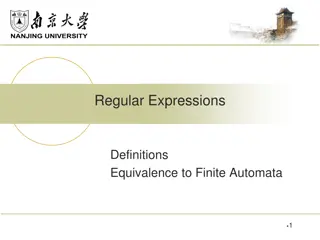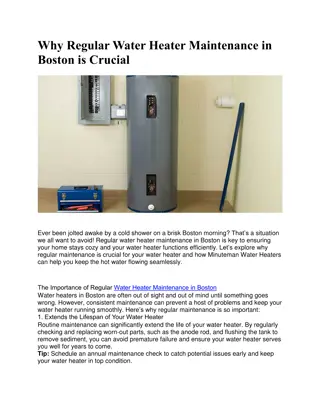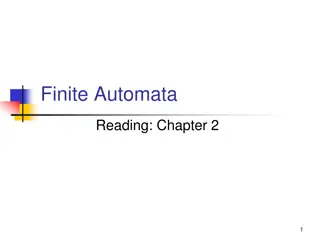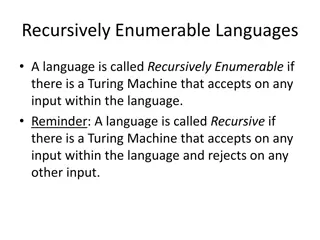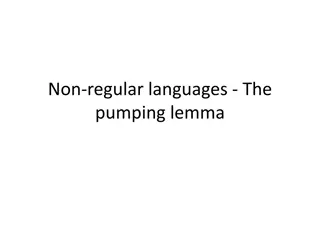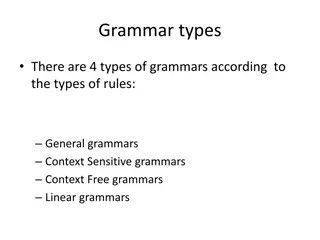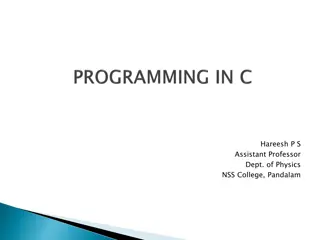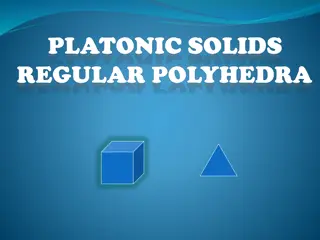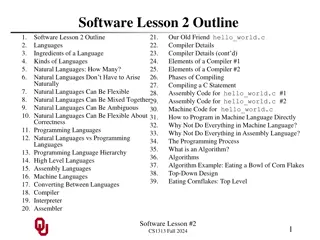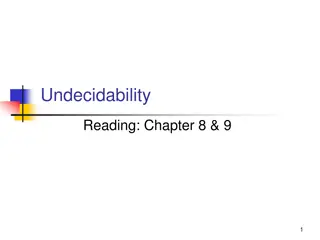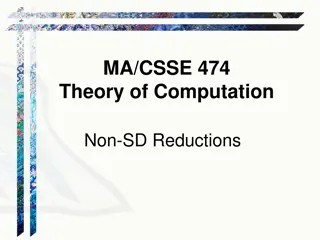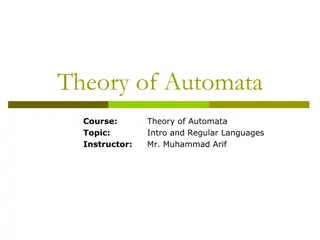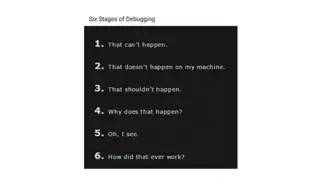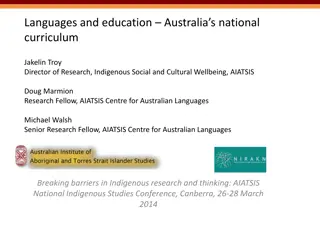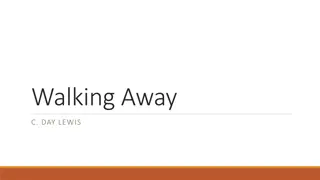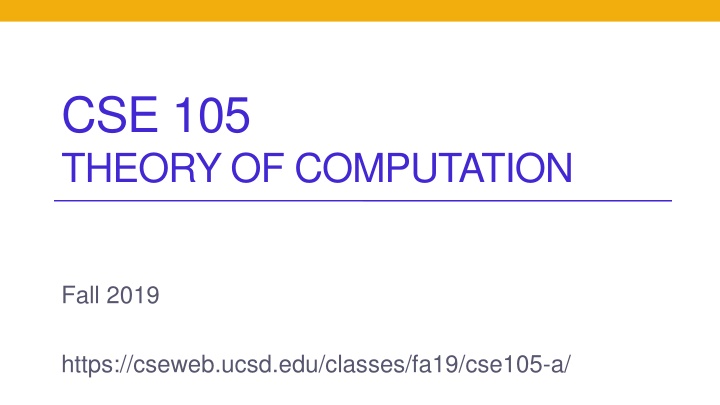
Theory of Computation Fall 2019: Learning Goals and DFA Design
Explore the learning goals of CSE.105 Theory of Computation in Fall 2019, covering topics on regular operations, closure properties, building DFAs, and complementation claims. Understand the process of designing DFAs to recognize specific patterns and languages. Delve into closure properties under different operations and the proof of regular languages being closed under complementation.
Download Presentation

Please find below an Image/Link to download the presentation.
The content on the website is provided AS IS for your information and personal use only. It may not be sold, licensed, or shared on other websites without obtaining consent from the author. If you encounter any issues during the download, it is possible that the publisher has removed the file from their server.
You are allowed to download the files provided on this website for personal or commercial use, subject to the condition that they are used lawfully. All files are the property of their respective owners.
The content on the website is provided AS IS for your information and personal use only. It may not be sold, licensed, or shared on other websites without obtaining consent from the author.
E N D
Presentation Transcript
CSE 105 THEORY OF COMPUTATION Fall 2019 https://cseweb.ucsd.edu/classes/fa19/cse105-a/
Today's learning goals Sipser Ch 1.1, 1.2 Review what it means for a set to be closed under an operation. Define the regular operations on languages Prove closure properties of the class of regular languages
Building DFA Remember States are our only (computer) memory. Design and pick states with specific roles / tasks in mind. "Have not seen any of desired pattern yet" "Trap state"
Building DFA New strategy Express L in terms of simpler languages use them as building blocks. Example L = { w | w does not contain the substring baba } = the complement of the set {w | w contains the substring baba}
Building DFA DFA recognizing {w | w contains the substring baba} DFA recognizing {w | w doesn't contain the substring baba}
Complementation Claim: If A is a regular language over {0,1}*, then so is A aka "the class of regular languages is closed under complementation"
Closure of under Z under addition. Set of even ints under multiplication. {0}* under concatenation. Which of these is true? Peterson 110: AD A. The set of odd integers is closed under addition. B. The set of positive integers is closed under subtraction. C. The set of rational numbers is closed under multiplication. D. The set of real numbers is closed under division. E. I don't know.
Complementation Claim: If A is a regular language over {0,1}*, then so is A aka "the class of regular languages is closed under complementation"
Complementation Claim: If A is a regular language over {0,1}*, then so is A aka "the class of regular languages is closed under complementation" Proof: Let A be a regular language. Then there is a DFA M=(Q, , ,q0,F) such that L(M) = A. We want to build a DFA whose language is A. Define M' = ? Claim of Correctness L(M') = A Proof of claim
Why closure proofs? General technique of proving a new language is regular Stretch the power of the model Puzzle!
The regular operations Sipser Def 1.23 p. 44 For A, B languages over same alphabet, define: These are operations on sets!
Union Sipser Theorem 1.25 p. 45 Theorem: The class of regular languages over fixed alphabet is closed under the union operation. Proof: What are we proving here? A. For any set A, if A is regular then so is A U A. B. For any sets A and B, if A U B is regular, then so is A. C. For two DFAs M1 and M2, M1 U M2 is regular. D. None of the above. E. I don't know.
Union Sipser Theorem 1.25 p. 45 Theorem: The class of regular languages over fixed alphabet is closed under the union operation. Proof: Let A1, A2 be any two regular languages over . WTS that A1 U A2 is regular. Goal: build a machine that recognizes A1 U A2.
Union Sipser Theorem 1.25 p. 45 Goal: build a machine that recognizes A1 U A2. Strategy: use machines that recognize each of A1, A2. M1 Accept if either (or both) accepts Input ** HOW? ** M2
Union Sipser Theorem 1.25 p. 45 Theorem: The class of regular languages over fixed alphabet is closed under the union operation. Proof: Let A1, A2 be any two regular languages over . Given M1 = (Q1, , 1,q1,F1) such that L(M1) = A1 and M2 = (Q2, , 2,q2,F2) such that L(M2) = A2 and WTS that A1 U A2 is regular. Define M = (?, , ,?,?)
Union Sipser Theorem 1.25 p. 45 Theorem: The class of regular languages over fixed alphabet is closed under the union operation. Proof: Let A1, A2 be any two regular languages over . Given M1 = (Q1, , 1,q1,F1) such that L(M1) = A1 and M2 = (Q2, , 2,q2,F2) such that L(M2) = A2 and WTS that A1 U A2 is regular. Define M = (Q1xQ2, , ,?,?) Idea: run in parallel
Union Sipser Theorem 1.25 p. 45 Theorem: The class of regular languages over fixed alphabet is closed under the union operation. Proof: Let A1, A2 be any two regular languages over . Given M1 = (Q1, , 1,q1,F1) such that L(M1) = A1 and M2 = (Q2, , 2,q2,F2) such that L(M2) = A2 and WTS that A1 U A2 is regular. Define M = (Q1xQ2, , ,?,?) What should be the initial state of M? A. q0 B. q1 C. q2 D. (q1,q2) E. I don't know.
Union Sipser Theorem 1.25 p. 45 Theorem: The class of regular languages over fixed alphabet is closed under the union operation. When r is a state in M1, s is a state in M2, and x is in , then ( (r,s), x ) = Proof: Let A1, A2 be any two regular languages over . Given M1 = (Q1, , 1,q1,F1) such that L(M1) = A1 and M2 = (Q2, , 2,q2,F2) such that L(M2) = A2 and WTS that A1 U A2 is regular. Define M = (Q1xQ2, , ,?,?) A. (r,s) B. ( (r,x), (s,x) ) C. ( 1(r,x), s ) D. ( 1(r,x), 2(s,x) ) E. I don't know.
Union Sipser Theorem 1.25 p. 45 Theorem: The class of regular languages over fixed alphabet is closed under the union operation. Proof: Let A1, A2 be any two regular languages over . Given M1 = (Q1, , 1,q1,F1) such that L(M1) = A1 and M2 = (Q2, , 2,q2,F2) such that L(M2) = A2 and WTS that A1 U A2 is regular. Define M = (Q1xQ2, , ,?,?) The set of accepting states for M is A. F1 x F2 B. { (r,s) | r is in F1 and s is in F2 } C. { (r,s) | r is in F1 or s is in F2 } D. F1 U F2 E. I don't know.
Union Proof: Let A1, A2 be any two regular languages over . Given M1 = (Q1, , 1,q1,F1) such that L(M1) = A1 and M2 = (Q2, , 2,q2,F2) such that L(M2) = A2. Sipser Theorem 1.25 p. 45 WTS that A1 U A2 is regular. Define M = (Q1xQ2, , ,(q1,q2),{(r,s) in Q1xQ2 | r in F1 or s in F2}) with ( (r,s), x ) = ( 1(r,x), 2(s,x) ) for each (r,s) in Q1xQ2 and x in . Why does L(M) = A1 U A2 ?
Intersection How would you prove that the class of regular languages is closed under intersection? Can you think of more than one proof strategy? A B = { x | x in A and x in B} U
Payoff { w | w contains neither the substrings aba nor baab} Is this a regular set?
Payoff { w | w contains neither the substrings aba nor baab} Is this a regular set? A = { w | w contains aba as a substring} B = { w | w contains baab as a substring}
Sample closure proofs The class of regular languages over {0,1} is closed under the FlipBits operation, where FlipBits(L) = { w | w is obtained from some w' in L by flipping each 0 in w to 1, and each 1 to 0} The class of regular languages of {a,b,z} is closed under the DeleteWordsWithZ operation, where DeleteWordsWithZ(L) = { w | w is in L and w doesn't contain z}
General proof structure/strategy Theorem: For any L over , if L is regular then [ the result of some operation on L ] is also regular. Proof: Given name variables for sets, machines assumed to exist. WTS state goal and outline plan. Construction using objects previously defined + new tools working towards goal. Give formal definition and explain. Correctness prove that construction works. Conclusion recap what you've proved.
The regular operations Sipser Def 1.23 p. 44 For A, B languages over same alphabet, define: How can we prove that the concatenation of two regular languages is a regular language?

